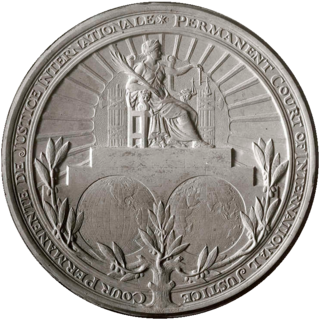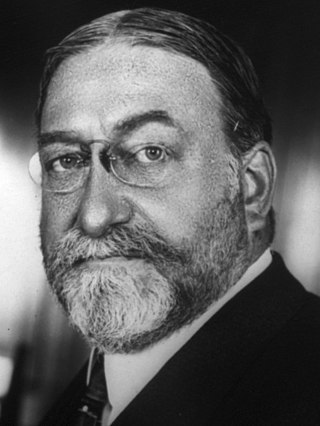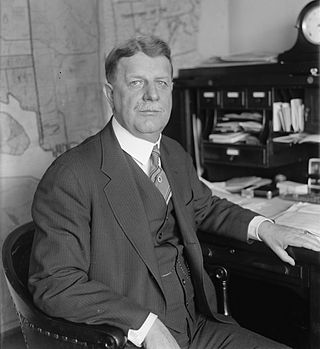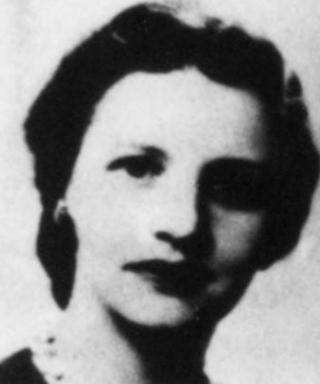The International Prize Court was an international court proposed at the beginning of the 20th century, to hear prize cases. An international agreement to create it, the Convention Relative to the Creation of an International Prize Court, was made at the Second Hague Conference in 1907 but never came into force.

The Permanent Court of International Justice, often called the World Court, existed from 1922 to 1946. It was an international court attached to the League of Nations. Created in 1920, the court was initially well-received from states and academics alike, with many cases submitted to it for its first decade of operation.

Antonio Sánchez de Bustamante y Sirven was a Cuban lawyer, educator, politician and international jurist. He promoted the existence of a common American regulation for private international law. For this reason, the sixth Pan-American Congress took place in Cuba in 1928, in the final document, the Treaty of Havana is attached in the annex of the Code of Private International Law.

Philip Caryl Jessup was a 20th-century American diplomat, scholar, and jurist notable for his accomplishments in the field of international law.
H. E. Eduardo Jiménez de Aréchaga was an Uruguayan professor, jurist, and President of the International Court of Justice.

John Bassett Moore was an American lawyer and authority on international law. Moore was a State Department official, a professor at Columbia University, and a judge of the Permanent Court of International Justice from 1922 to 1928, the first American judge to sit on that judicial body.

Sir Hersch Lauterpacht was a British international lawyer, human rights activist, and judge at the International Court of Justice.

James Brown Scott was an American legal scholar. He founded the law school at University of Southern California and was professor of law at University of Illinois, Columbia University, George Washington University, and Georgetown University. He was editor in chief of the American Journal of International Law, played a key role in founding the American Society of International Law, and was an expert to the United States delegation at the Second Hague Peace Conference.

The Covenant of the League of Nations was the charter of the League of Nations. It was signed on 28 June 1919 as Part I of the Treaty of Versailles, and became effective together with the rest of the Treaty on 10 January 1920.

John Charles Linthicum was a U.S. Congressman from the 4th Congressional district of Maryland, serving from 1911 to 1932.

Roberto Ago was an Italian jurist. He served as a judge on the International Court of Justice from 1979 until 1995. He was Professor of International Law at the Universities of Catania (1934–1935), Genoa (1935–1938), and finally Rome (1956–1982). He specialized in both private and public international law.

The American Society of International Law (ASIL) is a professional association of international lawyers in the United States. The organization was founded in 1906. After the Lake Mohonk Conference on International Arbitration, some participants felt the need for a society devoted to international law separate from international arbitration. Participants in a meeting held on December 9, 1905, at the residence of Oscar S. Straus agreed to establish the ASIL.

Manley Ottmer Hudson was an American lawyer specializing in public international law. He was a judge at the Permanent Court of International Justice, a member of the International Law Commission, and a mediator in international conflicts.

Walther Adrian Schücking was a German liberal politician, professor of public international law and the first German judge at the Permanent Court of International Justice in The Hague.
Sergei Borisovich Krylov was a Soviet diplomat and one of the authors of the UN Charter. He served as a judge of the International Court of Justice from its beginning in 1946 until 1952. He taught at the Moscow State Institute of International Relations. He was a leading Soviet scholar of international law. He advised the Soviet Union government during the negotiations leading up to the creation of the United Nations.
Åke Wilhelm Hjalmar Hammarskjöld was a Swedish lawyer and diplomat. He was the first Registrar of the Permanent Court of International Justice, serving from 1922 to 1936, when he was elected to the position of judge to the same court. He served in the latter position until his death.
Leo Gross was an Austrian - American lawyer of Jewish descent. He was a scholar in the area of international law and international relations and from 1944 to 1980 a professor at the Fletcher School of Law and Diplomacy of Tufts University.
Manuel Alejandro Álvarez Jofré was a Chilean professor of international law and a judge at the International Court of Justice. He had been a founding member of the American Institute of International Law and of the Institute of Higher International Studies, from the Faculty of Law of Paris. He served as a judge in the International Court of Justice in 1946–1955.

Charles Marie Joseph Désiré de Visscher was a Belgian scholar and practitioner of international law, as well as judge on the Permanent Court of International Justice and International Court of Justice.

Ruth Elizabeth Bacon was an American foreign service officer, a Far East specialist. She was one of the first six annual recipients of the Federal Woman's Award, in 1961. In 1968, she retired as director of the Office of Regional Affairs in the Bureau of East Asian and Pacific Affairs, at the United States Department of State.














